For thousands of years man has used the bow and arrow for hunting and for war. Many indigenous tribes around the world used archery, and it became the primary weapon of war in the dark ages.
Every development in weapons technology has always either increased lethality or increased range. For example, stone or metal arrowhead when combined with the arrow speed make archery incredibly lethal.
Many archery setups can pierce armor and bone. In addition, bows will allow an archer to shoot accurately at 40 yards to 100 yards depending on the skill of the archer. This compares to spears or atlatls with a much more limited range and lethality.
In modern times, most people use archery for hunting. Since the invention of the rifle, archery has largely retired from modern warfare. However, archery can be used for self defense in an emergency.
Related: Best Household Self-Defense Items You Probably Have In Your Home Right Now
In many ways, archery can be more effective when SHTF.
In this article, we will cover the different types of bows that can be used in and emergency. We will discuss other equipment you need, how to prepare your home, and strategies to successfully use archery to defend yourself.
Types of Bows
The three primary types of bows that could be used for home defense are compound bows, recurve bows, and crossbows.
Each of these have their own advantages and disadvantages. Let’s review them:
Compound Bows – Most modern bows are compound bows with wheels to reduce draw weight after a let off point. These bows allow you to pull and hold your draw for a longer time so you can aim or remain still while your target shifts.
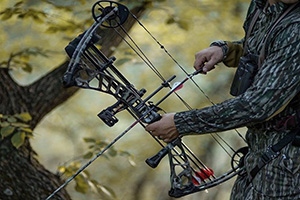
Compound bows deliver high arrow speeds with a small amount of bowstring noise when you fire. This means you can fire at a target without alerting other people to your presence.
If you are good, you can take out three or four targets before they realize what’s happening.
The downsides are reload time and maneuverability. Compound bows take longer to draw, fire, and reload than a recurve. This makes it tough when targets are in close.
Also, carrying around a compound bow in an urban setting is not ideal. Trying to stay hidden while maneuvering around corners in hallways would be difficult.
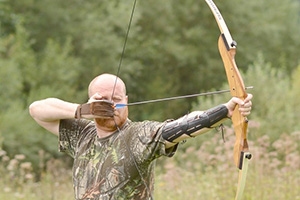 Recurve Bows – This is the oldest technology of the three bow types. Recurve bows rely entirely on the energy released from the arms of the bow.
Recurve Bows – This is the oldest technology of the three bow types. Recurve bows rely entirely on the energy released from the arms of the bow.
The arrow speed is not as high as a compound bow so there is not as much killing power.
However, recurves are quiet and quick. You can draw, aim, and fire in just a second or two.
Many people use recurves for hunting quick targets like birds or small game. They are even longer than a compound bow, so sneaking around in buildings is not ideal.
Crossbow – You can get crossbows in both compound and recurve versions.
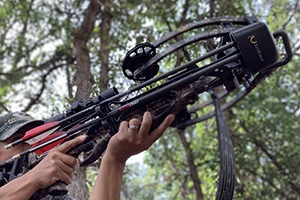
Crossbows are the most accurate of the three options because you can use a scope and hold it like a rifle.
The arrow speeds are high like a compound bow, so there is maximum lethality. It is smaller like a rifle, so it is the best option for tight spaces.
The only downside is that the crossbow is the slowest to reload.
Arrows and Arrowheads
Your choice of arrows and arrowheads is important for tactical purposes. Your choice of arrow shafts is typically fiberglass, aluminum, or wood.
I would suggest fiberglass for survival purposes. Wood shafts break and aluminum shafts bend, but fiberglass flexes when needed so the arrow can be reused for years.
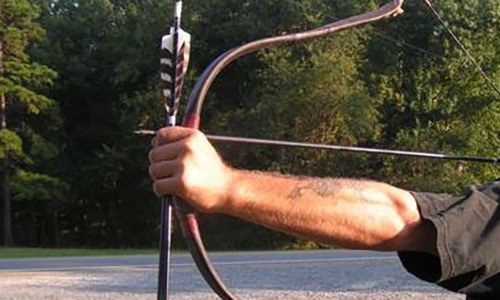 However, one advantage of archery is that you can make arrow shafts if needed. If you run out of fiberglass, use whatever materials you can find to keep fighting.
However, one advantage of archery is that you can make arrow shafts if needed. If you run out of fiberglass, use whatever materials you can find to keep fighting.
Related: How To Make a Glass Arrowhead
As for arrowheads, you need some sort of broadhead for tactical purposes. A field point could easily hit a target and do little damage. An attacker could pull out the arrow and keep coming.
Broadheads penetrate deep and cut open tissue. They do more damage, hit harder, and are harder to remove.
You can use traditional broadheads, but I prefer mechanical broadheads. Mine fly just like a field tip but the blades flip out when the arrow hits the target. They leave a wound two to three inches in diameter.
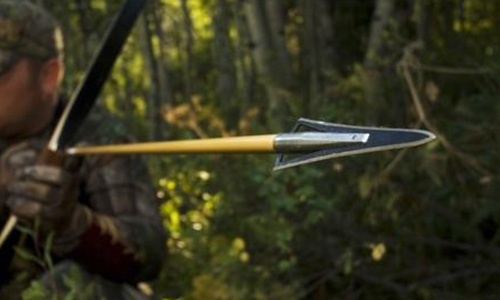 Prepping for Tactical Archery
Prepping for Tactical Archery
If you want the option of defending your home with a bow and arrow, you need to have the house set up for these purposes. If you have a way to get on the roof, that will give you the best point from which to hit all approach angles.
On our home, I could use the chimney as cover and still stay high on the roof.
Related: How To Prepare Your House Against Looters
Windows are another option. If you look at the design of medieval castles, they usually had tall, narrow windows on the second story. These were designed so archers could fire at a variety of angles without exposing themselves to incoming fire.
You can accomplish the same effect by attaching two pieces of particle board or plywood across a window with a five or six-inch vertical gap between the two boards.
Once the window is open, you have a perfect perch to fire arrows without completely exposing yourself. If you are using a crossbow, consider placing a shooting stick by the window. This would give you even more stability when aiming your shots.
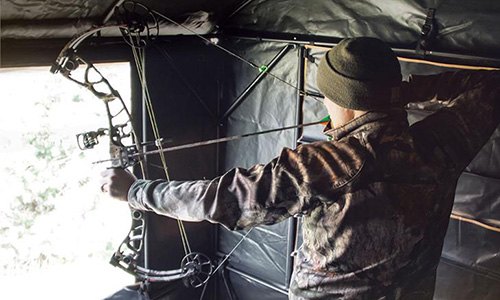 In addition to having a plan for your home, you need to practice. Prior to bow hunting season, I typically practice at least 30 minutes a day five days a week for a few months.
In addition to having a plan for your home, you need to practice. Prior to bow hunting season, I typically practice at least 30 minutes a day five days a week for a few months.
Especially with a compound or recurve bow, practice will make a huge difference in your accuracy. I like to have consistent three inch groupings at 40 yards to be satisfied.
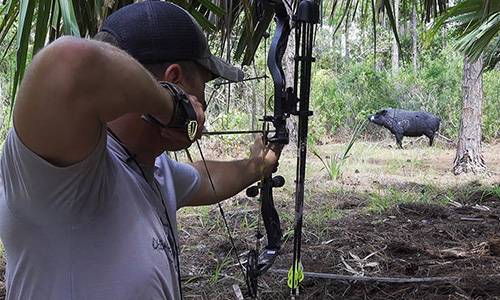 Finally, be sure you have lots of arrows ready. You likely will not be able to run into the yard and gather arrows up. You should have enough to take out your attackers without collecting fired arrows.
Finally, be sure you have lots of arrows ready. You likely will not be able to run into the yard and gather arrows up. You should have enough to take out your attackers without collecting fired arrows.
How to Take Action
When the time comes to defend your home, you must take action quickly. Get your bow and arrows and get to your preselected perch. Always fire for center mass and take out easy targets first. Anyone out in the open that is standing still should be eliminated first. Then move to stationary targets taking cover.
Finally, you can try to take out moving targets. If possible, you should have one or more other people on the ground level to take out anyone that gets past your shots. Keep in mind that attackers can be hit center mass and can still have the strength to bust into your home. Have a contingency plan for that scenario.
While firearms are typically the weapon of choice in an emergency, they do have downsides. The biggest one is that guns are loud. If there is a group of 20 looters but they are spread out to cover several houses, a gun shot could bring them all running. You can be sure they are looking for guns.
However, with the right archery setup, you can pick them off one at a time without alerting the rest of the group. Take your time to purchase the right gear, develop a plan for your home, and start practicing as often as possible.
You may also like:
 Personal Locator Beacon: A Must Have Item For Survivalists
Personal Locator Beacon: A Must Have Item For Survivalists
US Nuclear Target Map. Do You Live in The Danger Zone? (Video)

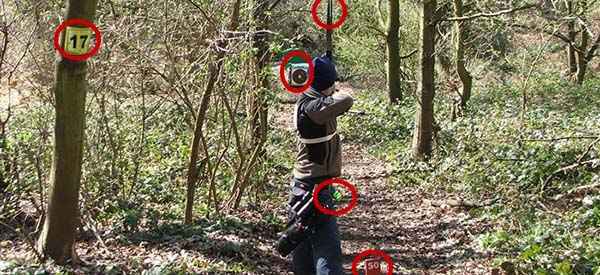













Archery is great! The felling of shooting a bow is good for improving focus, patience and even shooting skills.
I practice three times a week with my compound bow. I can get four arrows off a minute at 60 yards at about 80% accuracy depending on wind conditions. The bow draw pressure is about 60lb draw. I use international orange colored practice shafts with blunt tips about the same weight as a broadband so I can recover them easily. I find a scope unreliable, using the string sight and post instead. This keeps things simple, and there is no reflection from the optic glass in case the Sun reflects off one. Muscle “memory” is extremely important for accuracy, so practice as much as you can. Silence when being assaulted is so very important. Any impact in center of mass is fatal with the triple broadband, so many wound channels are created for the attacker to “bleed out”. A very lucky head shot drops the intruder instantly, even if the arrow glances off the skull but creates a concussion disabling the target. A blunt tipped arrow also can be a non lethal “warning” if the situation warrants. If you put the fletching on at a slight angle, it can help stabilize the arrow by causing it to twist in the air without losing too much velocity. But the way to handle a bow of any kind is to practice as much as you can with the proper equipment.
Thanks for a great article.
I know your article is mainly about archery self defense. There’s a lot to be said about an accomplished archery hunter. Hunting with bow & arrow can be very challenging and very rewarding too.
I may be wrong but I believe the long bow was developed before the recurve.
Personal preference on selecting archery equipment varies as much as selecting firearms in my opinion.
For the most part our family shoots carbon fiber arrows from compound bows. For hunting, fixed blade broadhead points are used. My son stopped using the mechanical points when one failed to open when he shot a deer. It may have hit bone…who knows…all I know is the blades didn’t deploy. I’ve seen very few deer shot with an arrow that the arrow didn’t go completely through.
Like you said practice is key to success. My son & grandson start practicing mid summer. I’m gonna brag a bit here but by the time archery deer season opens they can consistently can shoot a 1.5″ group at 40 yards.
Arrows are expensive and they usually Robin Hood an arrow or two even aiming at different spots on the target. They work their way up to practice shooting out to 60 yards but limit hunting shots to 25 yards.
Thanks again for a great article…lots of great info and lots to consider.
If you’re considering traditional archery you should check out 3 Rivers Arvhery…Great products and my experience…great people to deal with.
Ummmmmmm no. Hunting post shtf, yeah, okay but becoming a night ninja picking-off bad guys ala Rambo …. ummmmmmmm, no.
Gallo P:
Why “no”? Like any other weapon, you need to practice with a bow and arrow to achieve any sort of proficiency. Like any other weapon, a bow and arrow is deadly in the hands of a trained person.
While firearms are more powerful and can have a better range and accuracy, certainly there are many advantages to using a bow and arrow in certain circumstances, not the least of which is the fact that you can learn to make your own, nor is there currently the scrutiny that is present in purchasing a firearm in many states. Perfectly usable archery equipment can legally be purchased in many locations at thrift stores and yard sales. You can’t do that with a gun most places.
There may come a time in the US that private ownership of firearms will be illegal, or so restricted that it will be very difficult.
It is in our own best interests to explore all options for personal defense and hunting.
Good article! I use to be superwoman. 🙂 I could keep up and do anything around the farm and woods. We taught the girls to shoot bows. I fractured and compressed the T9 vertebrae in my spine which is right between the shoulder blades. It will never heal. Are there any suggestions for a type of bow I could use that won’t cause pain? Self loading etc.
Some crossbows have a cocking device that kinda resembles a small boat trailer wench. The ones I watched demonstrated was easy and hardly any effort at all. I’ll have to refresh my memory but I think most of the crossbows I was looking at could have a crank installed if it didn’t come with one. The ones I was looking at were 195lb draw so I’m not sure I could cook one without a crank.
I’ve had biceps reattached on both arms and surgery on both shoulders so drawing my 55lb recurve is not as easy as it once was and kinda painful. My son & grandsons are trying to talk me into getting a crossbow last deer season…I’m just not there yet…and the better ones I looked at were around $1000 – $1300.
I think that cranking mechanism is called a Windlass.
Decent crossbows are available from about 250 dollars, add another hundred for the crank cocking device. Extra arrows (bolts) will run 2.50 and up each by the dozen. My new Killer Instinct crossbow has a draw of about 200 pounds which with the rope cocker means a bit over 50 pounds with each hand, but the let off from the compound cams makes it relative easy to set. If my wife or daughters want to use it I will need to get the crank cocking device. At 25 yards it will drive a 20 inch target point thru 2 bales of straw. I have not chronographed it yet but the maker claims 400 plus feet per second. Bow, scope,rope cocker,3 carbon fibre arrows and lube
Got it on line from Sportsmans guide.com
I forgot to add a warning to all those superwomen out there. How did I fracture and compress the T9 in my spine?
Do not lift and move a window AC by yourself! Wait for your better half to give you a hand.
Use the ammo on 2 legged prey.
Use the arrows & bolts (crossbows) on 4 legged prey.
Bow and arrow on the plus side:
They’re silent.
Relatively inexpensive compared to guns, plus if you’re handy you can make your own – lots of info out there on how to do that.
You don’t need a license, (especially if you make your own) so “the Man” won’t know if you have one or not.
If you have space and are away from nosy neighbors, you can practice anytime. Again, no noise to give you away, and you can circumvent those pesky “using a firearm in a residential area” laws.
Negatives:
Bulky – very hard to conceal carry unless you put your stuff in a golf bag.
Takes more arm strength.
Not for close-quarter fighting/self defense.
Requires additional time to draw, knock, aim and release, repeat. Gun can fire as quickly as you pull the trigger.
Not as psychologically intimidating.
Can only take one shot at a time. See above.
The Comanche fought from horseback armed with a 50 lb flat bow. The old Indian fighter John S Ford said that, within a 10 yard range, the bow was equal to a Colt revolver in accuracy, stopping power, and even rate of fire. But the Rangers discovered it was pretty easy to duck an arrow fired from beyond 10 yards. Bow is a murder weapon, not a self defense weapon.
When your under attack, or being assaulted,… everything is a self defense weapon.
Has anyone tried using a blow gun? Closer range but can be lethal as well!
Pretty much requires poison darts to be more than annoying.
Curarey or equivalent may be hard to come by.
Bill:
Blow darts – now that sounds like good clean fun right there! Of course, you’d have to look up how to make curare or similar poison for maximum impact, but kidding aside, for letting air out of your enemy’s tires or small game they surely have a practical application.
I think that you can make bigger ones for game hunting, but don’t know how they compare to bow and arrow. You might be able to wound larger critters (like swamp denizens) enough for them to bleed out if you used a hollow point tip. Maybe recycled hypodermic needles for folk you really hate, give them hepatitis or AIDS even if you don’t kill them outright.
But of course, I speak of hypotheticals only, because that would be very very wrong and a horrible thing to suggest doing to the duly elected officials of our country….
…. wouldn’t it?
I knew a guy who hit a crack dealer with a blowdart. Back of his thigh, under the glutes. He said the guy dropped in mid-stride, like he passed out. Only he was fully conscious and screamed at the top of his lungs for several minutes.
Look up Cold Steel Razor Tip Broadhead Dart… I regularly hit center bullseye at a max of 33 feet.(regulation) Cannot use broadheads or spear darts in competition. Might change your mind about blowguns!…Bill
Or Pyramid Air has a 9 mm repeating pre-charged pneumatic rifle for $900 american. It will shoot ten shots, two five-round magazines before a reload is necessary. It has a sound suppressor on it and fire a 9 mm projectile at 700 feet per second. A quiet, hard-hitting, repeater. What’s not to like?
The only issue I see with this article is… “Your choice of arrow shafts is typically fiberglass, aluminum, or wood” and “I would suggest fiberglass for survival purposes.”
What about carbon fiber? That is by far the most prominent material nowadays for serious archers. The recommendation to use fiberglass for SHTF is not sound. Fiberglass arrows have a very short lifespan compared to carbon. Fiberglass warps easy and shatters easy. Carbon fiber is way more expensive, but your shafts will last forever.
or stock up on a lot of aluminum shafts, cost less than carbon fiber.
This was some great information,
I learn a lot that I did not know, ,
Thank you every one for sharing ,
That is why this is such a great site,
People that know what works best
Thank you
Just a quick quip on the set up of windows. If you look at most mid-evil type castles you will see a cross cut into the side of most of the ramparts. This was not for religious purposes. These are tactical murder slots for the bowmen to fire with greater accuracy and wider ranges with maximum protection. Just thought i would add that little tidbit.
A friend of mine owned a compound bow. He showed me a Deer hunting broadhead arrowhead. I would hate to be the person who got hit by one.